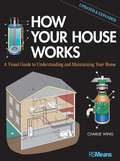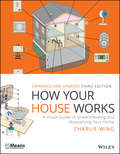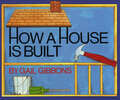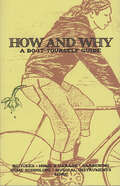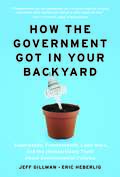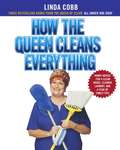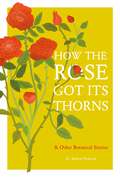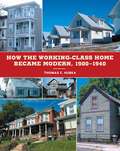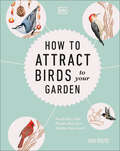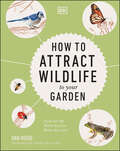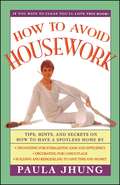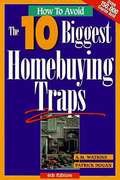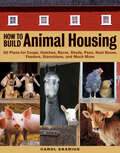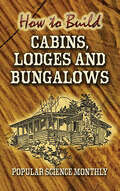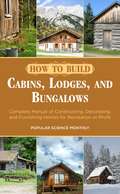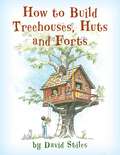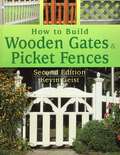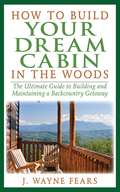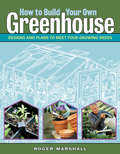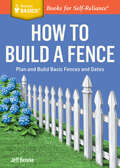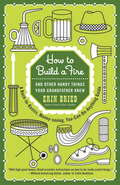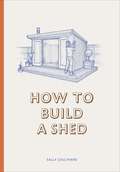- Table View
- List View
How Your House Works: A Visual Guide to Understanding and Maintaining Your Home
by Charlie WingUnderstand how to maintain everything in your home--including the kitchen sinkHow Your House Works, Second Edition reinforces the fact that it pays to be an informed consumer. Knowledge of your home's systems helps you control repair and construction costs and makes sure the correct elements are being installed or replaced. How Your House Works uncovers the mysteries behind just about every major appliance and building element in your house. Clear, full-color drawings show you exactly how these things should be put together and how they function, including what to check if they don't work.Covering topics such as electrical systems, heating and air conditioning, plumbing, major household appliances, foundation, framing, doors, and windows, this updated Second Edition has considerable additional information, with new chapters related to sustainability in and outside the house, as well as new topics, including clock thermostats, ventless gas heaters, moisture and mold, and passive solar heating.Illustrated guidance on electrical systems, heating and air conditioning, plumbing, major household appliances, foundation, framing, doors, and windowsIncludes a wealth of additional information, with new chapters related to sustainability and outside the houseFeatures new topics that include clock thermostats, ventless gas heaters, moisture and mold, LED lamps, motion-activated light switches, and passive solar heatingPresented in a richly illustrated with full-color drawingsWith see-through, cross-section drawings that show you how things are put together and how they function, How Your House Works supplies you with the knowledge that just might save you having to call in a professional.
How Your House Works: A Visual Guide to Understanding and Maintaining Your Home (RSMeans)
by Charlie WingThe updated and highly illustrated guide to understanding how just about everything in your house works! The revised and updated third edition of How Your House Works is a hands-on guide that gives you the low-down on why your faucet is leaking, your dishwasher is overflowing, or your furnace is on the fritz. This comprehensive book is your reference to virtually everything in your house with richly illustrated explanations of electrical systems, heating and air conditioning, plumbing, major household appliances, foundation, framing, doors, and windows. This must-have book answers most questions homeowners face when repairs are needed or when a new house or addition is in your future. How Your House Works is filled with easy-to-understand illustrations that show how things should be put together and how they function. The book also highlights issues outside the house as well as clock thermostats, ventless gas heaters, moisture and mold, and passive solar heating. Using the illustrations and the author’s clear explanations might save you the expense of calling a professional. This invaluable guide: Offers a colorful resource to home electrical systems, HVAC, plumbing, major household appliances, foundation, framing, doors and windows, sustainability, and much more Includes easy-to-follow information for troubleshooting problems Contains dozens of new full-color illustrations Presents new chapters on solar power and smart home technologies Helps homeowners save money on many common household repairs Written for homeowners with little or no knowledge of home maintenance or repair, How Your House Works is your illustrated and updated guide to understanding how appliances, electrical, plumbing, heating, air conditioning, and more work!
How a House Is Built
by Gail GibbonsHouses are built with many different materials, and in many shapes and sizes. Step by step, this picture book explains how homes are built—from the architect's plans through the arrival of a happy family. The many processes of construction are explained with simple language and bright, clear illustrations, perfect for kids starting to wonder about how the world around them works. Many different careers—including carpenters, plumbers, electricians, and landscapers—are introduced, each doing their part to bring the picture wood-frame house to life. A great read for kids who love construction sites, or who can't get enough of Building a House by Byron Barton. According to The Washington Post, Gail Gibbons "has taught more preschoolers and early readers about the world than any other children's writer-illustrator." Ms. Gibbons is the author of more than 100 books for young readers, including the bestselling titles From Seed to Plant and Monarch Butterfly. Her many honors include the Washington Post/Childrens Book Fuild Nonfiction Award and the NSTA Outstanding Science Trade Book Award.
How a Seed Grows (Let's-Read-and-Find-Out Science 1)
by Helene J. JordanRead and find out about how a tiny acorn grows into an enormous oak tree in this colorfully illustrated nonfiction picture book.This is a clear and appealing environmental science book for early elementary age kids, both at home and in the classroom. Plus it includes a find out more activity section with a simple experiment encouraging kids to discover what a seed needs to grow.This is a Level 1 Let's-Read-and-Find-Out, which means the book explores introductory concepts perfect for children in the primary grades. The 100+ titles in this leading nonfiction series are:hands-on and visualacclaimed and trustedgreat for classroomsTop 10 reasons to love LRFOs:Entertain and educate at the same timeHave appealing, child-centered topicsDevelopmentally appropriate for emerging readersFocused; answering questions instead of using survey approachEmploy engaging picture book quality illustrationsUse simple charts and graphics to improve visual literacy skillsFeature hands-on activities to engage young scientistsMeet national science education standardsWritten/illustrated by award-winning authors/illustrators & vetted by an expert in the fieldOver 130 titles in print, meeting a wide range of kids' scientific interestsBook in this series support the Common Core Learning Standards, Next Generation Science Standards, and the Science, Technology, Engineering, and Math (STEM) standards. Let's-Read-and-Find-Out is the winner of the American Association for the Advancement of Science/Subaru Science Books & Films Prize for Outstanding Science Series.
How and Why: A Do-It-Yourself Guide (Diy Ser.)
by Matte Resist"I dream of a better world," writes zinester andHow and Why author Matte Resist in the intro to his new book. He continues, "To me DIY culture is about grabbing a little piece of that dream." What follows over the course of the next 176 pages is Matte doing what all dreamers must do-waking up from his dream, opening his eyes, and confronting what roadblocks and hurdles lie between him and his goal. Matte does this by laying down chapter upon chapter of blueprints for a better world. A sequel to our do-it-yourself handbook Making Stuff and Doing Things, How and Why gives us detailed, engaging, easy-to-use info on bicycles, home and garage, gardening, educating children, musical instruments, and the all-inclusive "everything else" section. If you dream of taking back your life and building a better world, How and Why might be your new best friend.
How the Government Got in Your Backyard: Superweeds, Frankenfoods, Lawn Wars, and the (Nonpartisan) Truth About Environmental Policies
by Jeff Gillman Eric HeberligBiotechnology—the future or a genetic time bomb? Renewable fuels—the key to cleaner air or just corporate welfare? Greenhouse gasses—baking the earth to death or just a needless worry? Plant patents—improving gardens and farms or just profiteering? When you stop to think about it, the government has its hand in every important environmental issue. And with the left and the right raucously disagreeing about whether the government’s policies are for good or for evil, it’s impossible for a concerned citizen to know what to think.How the Government Got in Your Backyard distills the science, the politics, and the unbiased, nonpartisan truth behind hot-button environmental issues from pesticides to global warming. By clearly representing what the left says, what the right says, what the science is, and what the facts are, Gillman and Heberlig don’t set out to provide the answer—they light the path so concerned citizens can uncover their own true and informed opinion. In this season of political discontent, the unbiased truth about environmental policies—free of political agendas—is as refreshing as it is fascinating.How the Government Got in Your Backyard is not for Republicans or Democrats, liberals or conservatives. It’s for anyone who is ready to get to the bottom line.
How the Queen Cleans Everything: Handy Advice for a Clean House, Cleaner Laundry, a
by Linda CobbA how-to manual for housekeeping amateurs and pros alike, How the Queen Cleans Everything is a collection of fast and ingenious tips from #1 New York Times bestselling author -- and housekeeping's royal lady -- Linda Cobb, the Queen of Clean®. It's all here. All of the Queen's miraculous tips and surprising shortcuts on how to solve hundreds of cleaning challenges -- inside and out. Let the Queen show you how to turn your home into a sparkling palace in no time at all. Learn how to put an end to washday drudgery with her collection of nifty and natural solutions for stress-free washing and ironing -- and enjoy a year's worth of tips, tricks, and picks for a cleaner house and a more organized life. But most of all, discover how the Queen's no-nonsense "tips and hints" method of housekeeping means less time cleaning your home, and more time enjoying it! Let the Queen show you: the best way to clean your kitchen and bathroom the multitude of natural stain removers that are hiding in your cupboard how to garden the natural way what to do for spots, stains, scorch marks, and odors why you shouldn't clean your windows with newspaper how to clean your carpet and bare floors the right way to allergy-proof your home what those care labels really mean how to treat troublesome stains and delicate fabrics...and much more! At last...all the Queen of Clean's® famous advice for a clean house, cleaner laundry, and a year of timely tips -- right at your fingertips! Don't be home without it!
How the Rose Got Its Thorns: And Other Botanical Stories
by Dr Andrew OrmerodHave you ever wondered why the rose has thorns and other flowers don't; why the daffodil is the colour it is; or why some plants have shiny leaves and others matt?How The Rose Got its Thorns reveals the inner workings of our favourite flowers and trees. Designed to help gardeners, both novice and experienced, better understand how plants grow, the book is easy to navigate - it is divided into 50 chapters, each one a story.Accompanied by specially commissioned colour illustrations, each chapter explains the science behind how plants work and the extraordinary processes they have evolved: such as protecting themselves from predators using chemicals; attracting pollinators using scent, shape and colour; growing in low or high temperatures; their relationship with the wind; the size and pattern of their leaves; the distribution of their seeds and survival strategies; their relationship with insects; how they allocate their resources; and how they retain water efficiently.This delightful and intriguing book offers readers an accessible way to better understand how our plants evolved into the species of today.
How the Rose Got Its Thorns: And Other Botanical Stories
by Dr Andrew OrmerodHave you ever wondered why the rose has thorns and other flowers don't; why the daffodil is the colour it is; or why some plants have shiny leaves and others matt?How The Rose Got its Thorns reveals the inner workings of our favourite flowers and trees. Designed to help gardeners, both novice and experienced, better understand how plants grow, the book is easy to navigate - it is divided into 50 chapters, each one a story.Accompanied by specially commissioned colour illustrations, each chapter explains the science behind how plants work and the extraordinary processes they have evolved: such as protecting themselves from predators using chemicals; attracting pollinators using scent, shape and colour; growing in low or high temperatures; their relationship with the wind; the size and pattern of their leaves; the distribution of their seeds and survival strategies; their relationship with insects; how they allocate their resources; and how they retain water efficiently.This delightful and intriguing book offers readers an accessible way to better understand how our plants evolved into the species of today.
How the Working-Class Home Became Modern, 1900–1940 (Architecture, Landscape and Amer Culture)
by Thomas C. HubkaThe transformation of average Americans&’ domestic lives, revealed through the mechanical innovations and physical improvements of their homes At the turn of the nineteenth century, the average American family still lived by kerosene light, ate in the kitchen, and used an outhouse. By 1940, electric lights, dining rooms, and bathrooms were the norm as the traditional working-class home was fast becoming modern—a fact largely missing from the story of domestic innovation and improvement in twentieth-century America, where such benefits seem to count primarily among the upper classes and the post–World War II denizens of suburbia. Examining the physical evidence of America&’s working-class houses, Thomas C. Hubka revises our understanding of how widespread domestic improvement transformed the lives of Americans in the modern era. His work, focused on the broad central portion of the housing population, recalibrates longstanding ideas about the nature and development of the &“middle class&” and its new measure of improvement, &“standards of living.&”In How the Working-Class Home Became Modern, 1900–1940, Hubka analyzes a period when millions of average Americans saw accelerated improvement in their housing and domestic conditions. These improvements were intertwined with the acquisition of entirely new mechanical conveniences, new types of rooms and patterns of domestic life, and such innovations—from public utilities and kitchen appliances to remodeled and multi-unit housing—are at the center of the story Hubka tells. It is a narrative, amply illustrated and finely detailed, that traces changes in household hygiene, sociability, and privacy practices that launched large portions of the working classes into the middle class—and that, in Hubka&’s telling, reconfigures and enriches the standard account of the domestic transformation of the American home.
How to Attract Birds to Your Garden: Foods they like, plants they love, shelter they need
by Dan RouseHelp your local wild birds by providing them with a safe garden environmentMake a difference to your local birdlife. Help reverse the decline in bird numbers by creating a haven in which they will thrive. It's a win-win. Provide the best shelter, feeding, and nesting opportunities for them and then you can reap the rewards as they sing and entertain.No need to be an expert gardener already, or to break the bank - many of the most beneficial features can be installed easily and cheaply, and many you can build yourself or upcycle to be eco-friendly.
How to Attract Wildlife to Your Garden: Foods They Like, Plants They Love, Shelter They Need
by Dan RouseTransform your garden into a haven for all kinds of wildlife.In a world with too much concrete and not enough greenery, every wildlife-friendly garden can make a huge difference. But what if we told you that you can make a difference to your local wildlife from the comfort of your own home? You can help to reverse the decline in bird numbers and much more by creating a haven in which they will thrive! Let author, presenter, and wildlife conservationist Dan Rouse show you how you can make your outdoor space more welcoming for a wide variety of visitors, from planting pollinator-friendly perennials to digging a pond. Learn the best ways to provide shelter, food, and water, discover the best planting choices and how they can help, then sit back and watch as your garden becomes a much-needed refuge for a huge range of species.Dive straight in to discover:- A beautiful mixture of full-color illustrations and photos of different species.- Practical advice on supporting local wildlife, with ideas suitable for all budgets and abilities.- Suggestions for beneficial plant choices for a range of climate and soil types.- Step-by-step projects tailored to both attracting wildlife and to observe the wildlife that visits the garden.- Ideas for small gardens and outdoor spaces, as well as practical considerations such as pets and children sharing a garden with wildlife.- Final chapter on &‘Observing garden wildlife&’ that showcases low- and high-tech methods of watching for wildlife, and how to connect with the wider wildlife community. The book features plenty of projects to help you attract and observe your new garden visitors, as well as galleries of common species you can expect to see. Following in the footsteps of its sister title How to Attract Birds to Your Garden, everything in the book is clear, accessible, and engaging, with plenty of budget-friendly tips and ideas suitable for gardeners and non-gardeners alike. Packed with equal parts expertise and passion, How to Attract Wildlife to Your Garden proves that, by giving nature opportunities to thrive, we all benefit: ourselves, our planet, and the wildlife that may call our garden home.
How to Avoid Housework: Tips, Hints and Secrets to Show You How to Have a
by Paula JhungHousehold tips by a popular columnist include fast tidy jobs for unexpected visitors, organizing clutter, creating a self-maintained kitchen, coping with mess-makers, and keeping the bathroom clean.If you think it’s not possible to have a virtually self-cleaning home—think again! America’s self-proclaimed “#1 Avoidance Expert” tells all in this often hilarious, always smart, and eminently practical compendium of tips, hints, and secrets to maintaining a spotless home by barely lifting a finger. Would you rather arrange flowers and light candles than dust the table they sit upon? Would you rather sweep the dust under the rug than vacuum it? Here at last, in this terrific “antihousework” bible, Paula Jhung blends artful advice, a soupcon of illusion, and a bucketful of wit to whip up super solutions for the “I Hate to Housekeep” brigade. Sweeping (quickly) through every room in the house, Jhung gives you the dirt.
How to Avoid the Ten Biggest Home-Buying Traps
by Patrick Hogan A. M. WatkinsBuying a house can be a wonderful experience if you understand not only what to buy, but also what not to buy. But can you avoid common homebuying mistakes if you don't know what they are? Let How to Avoid the 10 Biggest Homebuying Traps guide you safely through the process of buying your home by showing you what pitfalls to identify and sidestep. With this guidance, you can successfully navigate potential money traps to find the home of your dreams. How To Avoid the 10 Biggest Homebuying Traps reveals the ten most common, and costly, mistakes homebuyers make. Guided by real estate expert Art Watkins, you'll learn how to spot and avoid: Houses that are overpriced for their value New construction by shady builders Homes that are marginal in quality Houses packed with special features for an impulse buy Garbled floor plans that reduce a home's value Homes that are expensive energy guzzlers, and much more.
How to Build Animal Housing: 60 Plans for Coops, Hutches, Barns, Sheds, Pens, Nestboxes, Feeders, Stanchions, and Much More
by Carol EkariusWith dozens of adaptable plans for sheds, coops, hutches, multipurpose barns, windbreaks, and shade structures, this guide covers everything you need to know to build safe and sturdy housing for your animals. Stressing the importance of evaluating your goals, planning ahead, and budgeting accordingly, Carol Ekarius helps you determine the best structure for your particular situation and offers expert advice on tools and construction techniques. Build a functional and comfortable house for your animals that they’ll be proud to call home.
How to Build Cabins, Lodges and Bungalows
by Popular Science Monthly"Nothing could be more American than the simple cabin. Not many generations ago, it was the backbone of American life, the headquarters of that important unit, the home. It provided shelter, protection, and a foundation upon which to build a great empire. The pioneer cabin was, in other words, a necessity." -- From the IntroductionOnce regarded as a safe haven and a vital source of security, the little cabin in the country is today more closely associated with leisurely activities -- a vacation spot and even a health investment. First published in the 1930s, this helpful guide was designed to provide vacation home builders with all the information they needed to construct, decorate, and furnish a rustic little cottage. Floor plans and outlines of necessary materials are included, as are tips on constructing foundations, porches, doors, windows, fireplaces, and other structural elements. There are even suggestions for furnishing and beautifying your cabin.A useful how-to manual, offering straightforward advice on the building process from foundation to roof, this practical book can also be enjoyed as an entertaining look at lifestyle elements of the early twentieth century.
How to Build Cabins, Lodges, and Bungalows: Complete Manual of Constructing, Decorating, and Furnishing Homes for Recreation or Profit
by Popular Science MonthlyMany generations ago, the cabin was the backbone of American life; it was the headquarters of that important unit-the home. It provided shelter, protection, and a foundation upon which to build a great empire. The pioneer cabin, understandably, was a necessity.Even in today's modern and complex world, many people still reside in cabins built to withstand permanent housing. In addition, cabins that serve as hunting and fishing lodges, summer cottages, and bungalows are seen as recreational luxuries. Cabins are healthy investments-when built correctly and cared for continuously, that is.Originally published in 1934, How to Build Cabins, Lodges, and Bungalows is both a historical and practical text that offers step-by-step instructions on how to build these structures and their various components: doors, windows, shutters, fireplaces, chimneys, porches, and more.In addition to shedding light on how cabins, lodges, bungalows-and even wayside stands and tourist homes-are built, the editors of Popular Science Monthly also included ideas for furnishing and decorating the finished homes and lodges, along with suggested lands on which to build them and tips on how to finance them.
How to Build Treehouses, Huts and Forts
by David StilesA treehouse is a wonderful idea, but how in the name of creation do you actually build one? In this delightfully illustrated handbook, David Stiles, the unofficial world grandmaster of the treehouse, shows how. Not assuming anything about the treehouse builder, Stiles starts with the basics: how to nail, how to buy wood, what kind of screws and nails to use. Then it's on to an A-frame design so simple that it can be built in a weekend out of four sheets of plywood, followed by lean-tos, a tree hut, and a Tarzan-style jungle hideaway. There are also forts of every description, including a 21-foot-tall lookout tower modeled on one George Washington built to keep an eye on the redcoats. Stiles also adds a design for a snowball catapult, an igloo and even a Nerf-loaded cannon. Written for children, with an adult peeking over their shoulder, Stiles's TREEHOUSES, HUTS, & FORTS is a dreamer's handbook, offering practical results.
How to Build Wooden Gates & Picket Fences
by Kevin GeistRevised and expanded, with new full-color photographs Steps for planning and locating a fence, setting posts, creating infill, and attaching gates Techniques for building the fence you want Advice on tools, materials, foundations, and special features Easy-to-use patterns Foldout of full-size pickets 130 designs included
How to Build Your Dream Cabin in the Woods: The Ultimate Guide to Building and Maintaining a Backcountry Getaway (Lyons Press Ser.)
by J. Wayne FearsHere is the ultimate resource for finally turning your dream into reality. With photos, blueprints, and diagrams, Fears thoroughly covers the process of constructing the cabin you've always wanted. From buying land, construction materials, deciding on lighting, the water system, and on-site constructions-such as shooting ranges, an outhouse, or an outside fire ring-this is a book filled with nuggets of wisdom from a specialist in the field: J. Wayne Fears is a wildlife biologist by training who has organized big-game hunting camps, guided canoe trips, and run commercial getaway operations. He built his own log cabin in the early 1990s and has been enjoying it ever since. Now you can build and enjoy the cabin you've always dreamed of, too.
How to Build Your Own Greenhouse: Designs and Plans to Meet Your Growing Needs
by Roger MarshallUnlock new growing opportunities and increase your property value with an outdoor conservatory. In this illustrated guide, Roger Marshall shows you how to build our own greenhouse using simple, easy-to-follow techniques. Covering everything from selecting a site to glazing glass, Marshall includes tips on laying a foundation, construction materials, ventilation, and much more. Whether your goal is to stretch the growing season or create a lush space for a year-round hot tub, you can build the greenhouse of your dreams.
How to Build a Fence: Plan and Build Basic Fences and Gates. A Storey BASICS® Title (Storey Basics)
by Jeff BenekeWhether you want to protect your garden, provide a safe enclosure for pets, or add privacy, this Storey BASICS® guide covers you everything you need to know to build the perfect fence. Offering clear step-by-step instructions, Jeff Beneke shows you how to construct a variety of fences from wood, vinyl, and chain link. With designs that are easily adaptable to all types of yards, you’ll soon be putting up a functional and beautiful fence that works with your landscape.
How to Build a Fire: And Other Handy Things Your Grandfather Knew
by Erin BriedA HANDY GUIDE FULL OF HOW-TO TIPS AND SAGE ADVICE FROM GRANDFATHERS As members of the Greatest Generation, our grandfathers were not only defined by the Depression but also by their heroic service to the country in World War II. Courageous, responsible, and involved, they understand sacrifice, hard work, and how to do whatever is necessary to take care of their loved ones. They also know how to have a rollicking good time. Sensible, fun, and inspiring,How to Build a Fireoffers a rare glimpse into the hearts and minds of grandfathers near and far by sharing their practical skills and sweet stories on how to be stronger, smarter, richer, and happier. Inside are more than one hundred essential step-by-step tips for fixing, leading, prospering, playing, and hosting, including how to bull; buck up and be brave in the face of adversity bull; play hard and break in a baseball mitt bull; bait a hook and catch a big fish bull; look dapper and tie a perfect tie bull; get a raise and earn more bull; write a love letter and kindle romance bull; change a flat tire and save the day bull; stand up and give a sparkling toast bull; play the harmonica and make your own music Loaded with charming illustrations, good humor, and warm nostalgia,How to Build a Fireis the perfect handbook for guys or gals of any age. The first of its kind, this collection of our grandfathers' hard-earned wisdom will help you build confidence and get back to what's really important in life.
How to Build a House with an Architect
by John M. BakerBuilding a house with an architect should be fun. The experience should be one of the most exciting and creative efforts in one's entire life. It can only be so, however, if the client and the architect enjoy that special rapport that comes from understanding how a house is designed and constructed.
How to Build a Shed
by Sally CoulthardEver dreamed of having your very own garden retreat? Off-the-shelf sheds aren’t always the answer - the cheap ones are badly made and freezing cold, and the better quality ones are really expensive. But what if you could build your own shed from scratch? How to Build a Shed is the ultimate practical guide. With its clear, easy-to-follow instructions, expert advice and specially commissioned illustrations, you'll be able to source the materials, choose the right tools and build your dream shed on a budget - even if you’ve never used a hammer.
